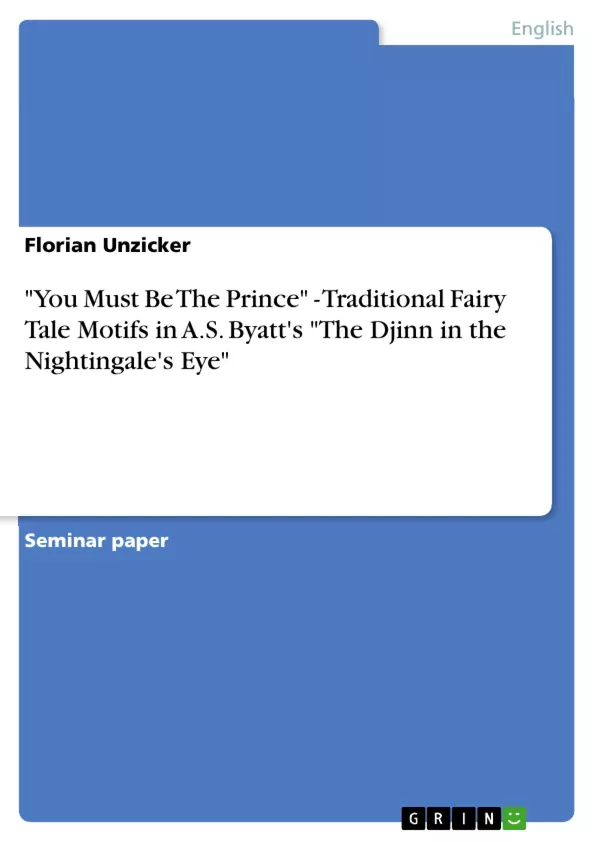The British female author A.S Byatt has always been fascinated by fairy stories, “from years of reading myths and fairytales under the bedclothes, from the delights and freedoms and terrors of worlds and creatures that never existed.” In 1994, she published her own collection of fairy tales, titled “The Djinn in the Nightingale’s Eye”. Four of the five tales are quite short and told in a narrative style typical for the genre, whereas the title story, which merges realism and fantasy, is of the length of a novella. The first two stories of the collection, “The Glass Coffin” and “Gode’s Story”, were originally published in Byatt’s successful novel “Possession” and are reprinted verbatim in combination with three new stories in “The Djinn in the Nightingale’s Eye”.
Byatt’s work is remarkably intertextual, “The Djinn in the Nightingale’s Eye” seems virtually to be a rich collage of fairy tale motifs. While the title story brims over with references to narratives of Oriental origin, as the Tales from Arabian Nights, the epics of Gilgamesh or the ancient myth of Cybele, and the works of Shakespeare and Chaucer, “The Glass Coffin” and “The Story of the Eldest Princess” are based on many themes and elements alluding to the traditional European fairy tales collected by Charles Perrault and the Brothers Grimm. Byatt herself mentions that “I read through the whole collection (in German) and made a kind of patchwork or jigsaw Tale out of all the motifs that most moved and excited me […].” This essay wants to examine how Byatt uses and transforms these familiar motifs, plots and characters from the “old stories” in order to give her heroines more power over her own life in her new stories.
[...]
Inhaltsverzeichnis (Table of Contents)
- Introduction
- The Sleeping Maiden
- The Fairy Tale Wedding
- The Three Siblings and the Quest
- Hunter, Woodcutter & Co.
Zielsetzung und Themenschwerpunkte (Objectives and Key Themes)
This essay examines how A.S. Byatt uses and transforms traditional fairy tale motifs, plots, and characters in her collection "The Djinn in the Nightingale's Eye," specifically focusing on how she empowers her heroines. The analysis centers on the reworking of familiar tropes to create narratives where female characters have greater agency.
- The portrayal of sleeping maidens in distress and their rescue by male figures.
- The transformation of traditional gender roles and expectations within fairy tale narratives.
- The intertextuality of Byatt's work and its relationship to various sources, including the works of the Brothers Grimm and Charles Perrault.
- The use of fairy tale motifs to explore themes of female empowerment and agency.
- The comparison of Byatt's retellings with feminist analyses of traditional fairy tales.
Zusammenfassung der Kapitel (Chapter Summaries)
Introduction: This chapter introduces A.S. Byatt's "The Djinn in the Nightingale's Eye" and its intertextual engagement with traditional fairy tales, highlighting Byatt's aim to empower her female characters.
The Sleeping Maiden: This section analyzes the motif of the sleeping maiden in distress, comparing Byatt's "The Glass Coffin" to the Brothers Grimm's tales and exploring feminist critiques of the traditional representation of passive female characters. It discusses the common trope of a male rescuer and its implications.
The Fairy Tale Wedding: (Note: This chapter summary is not provided in the source text.)
The Three Siblings and the Quest: (Note: This chapter summary is not provided in the source text.)
Hunter, Woodcutter & Co.: (Note: This chapter summary is not provided in the source text.)
Schlüsselwörter (Keywords)
A.S. Byatt, "The Djinn in the Nightingale's Eye," fairy tales, feminist fairy tale scholarship, gender roles, intertextuality, Sleeping Beauty, The Brothers Grimm, female empowerment, narrative transformation.
- Citar trabajo
- Florian Unzicker (Autor), 2007, "You Must Be The Prince" - Traditional Fairy Tale Motifs in A.S. Byatt's "The Djinn in the Nightingale's Eye", Múnich, GRIN Verlag, https://www.grin.com/document/122617



